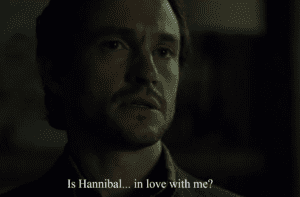That Sherlock has it’s issues is no secret: queerbaiting, lack of POC, treatment of women, you name it. So I decided to take a closer look at these and what makes them offensive by drawing comparison to a show I personally think handled things better.
The Infamous Queerbait
There are story conventions so universal, they sometimes feel self-evident. One of the most common is that if there’s a male and female lead, and that they’re going to fall in love, that’s just the way it is. So, when your leads are both of the same gender this often leads to a phenomenon we all know and hate: queerbaiting.
Queerbaiting is the practice of intentionally implying a queer romance via subtext without the intention of delivering on such romance. This is done at the expense of the LGBT+ community who are looking to media for representation.
A show often accused of queerbaiting is BBC’s Sherlock. Does it have a problem in this particular department? Yes, end of discussion.

But the fact is, subtext isn’t necessarily queerbaiting and sometimes not easily distinguished from the latter. So how can one tell whether one is being queerbaited or watching a slow-burn romance eventually intended to become text?
For this we are taking a closer look at both the aforementioned Sherlock and NBC’s Hannibal. Both are modern adaptions of earlier works (and in Hannibal’s case a prequel), that deviate so significantly from their source material that we can very well judge them on their own.
So why Hannibal, does it too have a queerbaiting problem? Not quite.
Hannibal was originally supposed to have a m/f main pairing, Will and Alana, but due to organic story development it never became more than a mutual crush. Alana trusted Hannibal over Will, their friendship grew cold and eventually Alana fell in love with and married multi-million-dollar heiress Margot Verger. So, a wlw power-couple is canon.
On the other hand, we have Will and Hannibal, a relationship that, while being at the center of the series was not at first intended to be romantic, and for good reason as there’s nothing healthy about it. (So far it contains about half a dozen attempts at murder.) Both creators and characters seem conscious of how unhealthy it is, but subtext kept piling up and was eventually moved into text. The way this was handled, reminds of Legend of Korra‘s treatment of Korrasami (though again, it’s not as positive a relationship).
Therefore, it is a suitable contrast for Sherlock and its blatant queerbaiting. We can use Hannibal to help identify how to distinguish queerbaiting from accidental or actual subtext.
First off, the one thing that annoyed me most about how John and Sherlock’s relationship was depicted: people tend to think they are romantically involved. Like, everybody just assumes. This literally happens in every episode up to John’s wedding (1×02, being the exception), often more than once.
There is no narrative reason for this to happen. Maybe once to establish there’s no romantic interest in each other, okay, twice, if you really think it’s necessary, but constantly?
John: We’re getting married. Well, I’m gonna ask anyway.
Mrs. Hudson: So soon after Sherlock?
John: Well, yes
Mrs. Hudson: What’s his name?
John: It’s a woman.
Mrs. Hudson: A woman?
John: Yes of course it’s a woman!
Mrs. Hudson: You really have moved on, haven’t you?
This is Mrs. Hudson, their landlady with whom they lived in the same house with for over a year.
The only explanations for this are you are either consciously keeping the option in the mind of the audience, which, if you don’t intend to deliver, would be queerbaiting. Or you think it’s funny, which would equate to a gay joke. Neither is a desirable option.
In Hannibal‘s case, implications that there may be more of a relationship than is publicly known first become a thing in the second season, which is also when the producers first noticed a romantic subtext. The only thing before that is Alana making a quip that Hannibal has adopted some of Will’s mannerisms late in season one.
What also contrasts Sherlock is that while Sherlock and John are always denying any assumptions made, this doesn’t happen on Hannibal.
Will: You called us ‘Murder Husbands’.
Freddie: You did run off to Europe together.
This example is the closest thing there is to the kind of constant joking seen on Sherlock. But in this case, Will’s anger is understandable since Freddie is a reporter on the hunt and Will is at this point married to Molly and not on the best of terms with Hannibal.
Another thing which can distinguish queerbaiting from subtext is framing, is there romantic music? Are forms of symbolism used? If not the probability of this being queerbaiting is a good deal higher.
Problematic Villain Coding

A queer coded villain is not sufficient representation, as it links “queerness” to evil, especially if the queer-coded villain continuously hits on the hero. Attempt at being funny or not, that is called harassment and having your queer-coded villain harass your ‘innocent’ (straight) hero is definitely problematic.
On Hannibal there are no queer coded villains. Tobias Budge would be stretching. Mason Verger may be flamboyant but he is also clearly female attracted. On to Sherlock, the most obviously queer-coded villain is Jim Moriarty.
Jim Moriarty is introduced as Molly’s boyfriend. He’s immensely queer-coded and hits on Sherlock who immediately points this out. It’s played for laughs, charming.
From here on whenever Moriarty encounters Sherlock he continues to flirt with and is shown to be obsessed with him. And then in season four there is this jewel:
“You like my Boys? This one’s got more Stamina, but he’s less caring in the afterglow…”
How are we supposed to take this, is he sleeping with his guards who work for him? Was this part of the job description? This alone would be considered offensive, but that is not the end of it.
The morally grey Irene Adler is presented as bisexual, which in combination with her mostly scanty clothing and her occupation as dominatrix is not too favorable in terms of bisexuals being hypersexualized.
And again, she is attracted to Sherlock and making advances even though it is (initially) making him uncomfortable. This is not presented as negative since she is a conventionally attractive woman.
Sherlock: I take it he did not consent?
Eurus: He?
Sherlock: She?
Eurus: He? She? I did not notice. After I was done it did not matter…
Eurus is another can of worms. There was no reason why she needed to speak to Sherlock, her brother, about having sex. The fact that she neither noticed the gender nor cared for the consent of her partner may be intended to show her as “evil”, but it unconsciously links sexual violence to queerness.
So, most villains on Sherlock are more or less queer and none of them care if people consent to their advances. That’s “Game of Thrones” levels of representation.
The ‘Other’ Women
The topic of queerbaiting ties in neatly with the treatment of other romantic relationships and women in general. If your two—in this case male—protagonists’ relationship is depicted as platonic, one or both of them may be in a relationship with somebody else, usually of the opposite gender. From the story’s treatment of this love interest, temporary or otherwise, it becomes clear which relationship is actually of interest to the protagonist.
The incorrect but common assumption is that a romantic relationship has to be the most important relationship in a person’s life. This is one of the many reasons people mistake platonic relationships for romantic ones, but that is not what I’m talking about here. The thing is, both the narration and the characters themselves should allot this romantic relationship a certain level of importance, even if not primary importance.
An example of this is Sherlock’s constant treatment of Molly’s feelings and his dismissal of John’s (mostly implied) long chain of dates and girlfriends. John doesn’t seem to care much either. Hell, there is a scene where his current girlfriend leaves him because she doesn’t want to compete with Sherlock. How much clearer can you show that their relationship is secondary to what John has with Sherlock, that this woman’s feelings too are secondary, just like those of Molly Hooper?

Molly’s treatment in general is atrocious. An unrequited crush is one thing, but it is a thing one eventually moves on from. Instead of showing Molly getting over Sherlock and eventually entering a healthy relationship, we first see her being used by the queern presenting Jim Moriarty. Her obliviousness of this fact is played for laughs. Then, she tries to impress Sherlock for Christmas, which is presented as her embarrassing herself. The writers follow this up with her engagement to a Sherlock look-alike whose personality she doesn’t even seem to like and the whole “I love you” fiasco in season four.
Irene Adler I already discussed above. She is sexualized and does not seem to care about making Sherlock uncomfortable. But she is attractive and who is not attracted to a beautiful woman, so Sherlock becomes obsessed with her. Although they barely know each other, she too is shown to be in love with Sherlock, who seems to be writing to her again at the end of season four (she was shown to be dying in season two, so there’s probably plot there).
Sherlock’s short relationship and engagement in season three are also treated poorly. First off, everybody is astonished about the fact that Sherlock is with a woman, as if the general consensus was that he wasn’t attracted to them. Then, it is revealed that he only used her for a case which, after a quick laugh, is soon brushed aside by the narrative.
Most recurring female characters are mostly there for Sherlock to antagonize or shout at. The way the narration treats Sally Donovan is poor to say the least, even before she disappeared without comment in season four. While it is clear Sherlock cares for Mrs. Hudson, this should not excuse his poor treatment of her either.

The first woman that is clearly allowed her place as a love interest in the narrative is Mary, John’s wife. Her relationship with John is mostly considered of equal importance to Sherlock’s. I honestly liked her being around, she was a smart woman with an established place in the story and was not just there on the side fetching tea or being helpful when men needed her.
But before the audience could get too used to her presence she gets killed off as soon as her plot function is fulfilled. The aftermath of her death is as much about Sherlock and John’s relationship as it is about her. The show even goes so far as to have her leave a message to her husband claiming that the “Baker’s Street Boys” are the ones that matter. Yeah, so much for that.
Hannibal does quite the opposite. A clear contrast to Sherlock are Hannibal’s relationships with Alana and Bedelia and Will’s relationship with Molly.
Season one gives Will and Alana’s mutual crush a sufficient buildup. Their trust, friendship and care for one another is acknowledged by others and exists independently from both of their dealings with Hannibal. Both are given space and time to be hurt after the kiss and the following decision to not enter a relationship.
Over the late first and the entire second season this trust and friendship dwindles as both of them get more and more entangled in Hannibal’s games. Unfortunately, Alana is usually the voice of reason in all things not Hannibal. This means her opinion is often dismissed in a “We have two conflicting opinions so I’ll pick the one I like better” way, which is eventually regretted by most of the characters in question.

After this, she becomes a more morally grey character. Not wanting to be hurt again and wanting to prevent Hannibal from hurting others, she starts hunting him down and eventually becomes his jailor and probable nemesis. While working for villain Mason Verger, she encounters Margot, his sister and victim. Alana falls in love with Margot, helps her kill Mason, marries her, and they have a son together.
Will’s fling with Margot in season two should also be mentioned, as it is more important to Margot’s arc. How it affects Will is not treated as more relevant than how it affects Margot. Her arc is then continued in season three, apart from Will, and eventually allows her to escape her abusive brother.
Bedilia knows Hannibal’s secrets from her time as his psychiatrist and yet chooses to run away with him. That he uses her is obvious, and she is aware of it. She is content to play Hannibal’s wife and does not initially plan to survive it. However, when it becomes clear that Hannibal would rather be with Will than with her, she cuts herself loose from him to live another day.
When Will marries Molly, he wants to leave it all behind. He rejected Hannibal, who then surrendered to the police and, locked up as he is, has no way of coming into Will’s life again. So Will starts over, he marries a mother, so he has a family, but doesn’t tell her about Hannibal. He only tells her enough so she know who to blame when things inevitably go wrong and her family is targeted by a killer. There is never a clear break-up, just a half-hearted “we will be okay” and the knowledge that their safe place is gone.
All these storylines are given room to breathe, these women have lives and they don’t just give up on their relationships. Whether they dodged a bullet or whether they close their eyes until it’s too late, they are just as much part of the story as Will and Hannibal are, and they are treated as such.
A grievance I do have here are Hannibal’s victims Abbigail Hobbs and Miriam Lass. Abigail in season one has a lovely arc dealing with the things her father did and how she helped him. After Hannibal faked her death in the end of season one, her story is no longer about her, but about what Will and Hannibal. Miriam Lass too is mostly seen in relation to Jack and his guilt. We never see her free herself of Hannibal’s control either. I would have loved seeing them be more of their own persons. Although it makes tonal sense in a way, as Hannibal does not consume their bodies like those other victims. He consumes their stories instead.
Racial Diversity
With the inclusion of POC, overall Hannibal does okay in this department. Jack Crawford, one of the most important characters in three seasons, is played by Laurence Fishburne, a black man. All three seasons too have a black and an Asian woman in starring or recurring roles.
Beverly Katz is killed by Hannibal in season two. Her death is a shocking twist (not sure if I should add a TM here, though) yet is immensely relevant to further plot and character development. We learn of Bella Crawford’s death early in season three. She had terminal lung cancer since early in season one, so it was not surprising, but still it was a pity to see her die. In season three Will encounters an old acquaintance of Hannibal’s, Chiyoh who lived with Hannibal’s aunt Murasaki as a child. When the plot reaches book material, Francis Dollarhide’s girlfriend Reba is played by Rutina Wesley, so I think there’s a slightly tokenistic feeling seeing one person of color die only for another to appear.
This is, however, still better than Sherlock whose only characters of color, Sally Donovan and John’s unnamed therapist, mysteriously disappear in season four leaving us with an all-white cast. And it’s not because it’s set in London, London is multicultural and diverse.
Overall I am a bit astounded just how much problematic stuff can be found if one goes looking for it. More than that, I’m floored that a show whose main characters are killers and cannibals somehow manages to do better than Sherlock.

